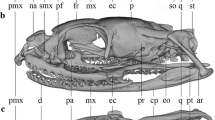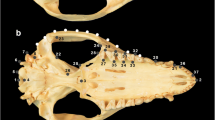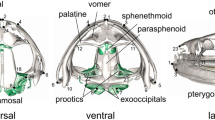Abstract
In this study, we applied geometric morphometrics to explore variations in the level and pattern of sexual size dimorphism (SSD) and sexual shape dimorphism (SShD) of the ventral cranium in three different Modern Eurasian newt taxa (Ichthyosaura alpestris, Triturus species group and Lissotriton vulgaris). The ventral cranium is the part of the skull that is more directly related to foraging and feeding. Our results indicate that the level and pattern of sexual dimorphism in the ventral cranium differ among Modern Eurasian newt taxa. Regarding sexual dimorphism in skull size, Ichthyosaura alpestris and Triturus species show female-biased patterns (females are larger than males), whereas Lissotriton vulgaris appears to be non-dimorphic in skull size. In I. alpestris and Triturus species, SShD is mostly absent, whereas in L. vulgaris, SShD is more pronounced. A high level of variation between populations in both SSD and SShD indicates that local conditions may have a profound effect on the magnitude and direction of sexual dimorphism. The significant sexual differences in ventral cranium size and shape indicate possible subtle intersexual differences in ecological demands due to diet specialisation, in spite of similar general ecological settings.




Similar content being viewed by others
References
Abouheif E, Fairbairn DJ (1997) A comparative analysis of allometry for sexual size dimorphism: assessing Rensch’s rule. Am Nat 149:540–562
Adams DC, Rohlf FJ, Slice DE (2004) Geometric morphometrics: ten years of progress following the ‘revolution’. Ital J Zool 71:5–16
Andersson M (1994) Sexual selection. Princeton University Press, Princeton
Babik W, Branicki W, Crnobrnja-Isailović J, Cogălniceanu D, Sas I, Olgun K, Poyarkov NA, Garcia-París M, Arntzen JW (2005) Phylogeography of two European newt species: discordance between mtDNA and morphology. Mol Ecol 14:2475–2491
Bookstein FL (1991) Morphometric tools for landmarks data: geometry and biology. Cambridge University Press, Cambridge
Bruner E, Constantini D, Fanfani A, Dell’Omo G (2005) Morphological variation and sexual dimorphism of the cephalic scales in Lacerta billineata. Acta Zool 86:245–254
Butler MA (2007) Vive le difference! Sexual dimorphism and adaptive patterns in lizards of the genus Anolis. ICB 47:272–284
Butler MA, Losos JB (2002) Mutivariate sexual dimorphism, sexual selection, and adaptation in Greater Antillean Anolis lizards. Ecol Monog 72:541–559
Cardini A, Elton S (2008) Variation in guenon skulls (II): sexual dimorphism. J Hum Evol 54:638–647
Denoël M (2004) Feeding performance in heterochronic alpine newts is consistent with trophic niche and maintenance of polymorphism. Ethology 110:127–136
Denoël M, Schabetsberger R, Joly P (2004) Trophic specialisations in alternative heterochronic morphs. Naturwissenschaften 91:81–84
Fairbairn DJ, Blanckenhorn WU, Szekely T (2007) Sex, size and gender roles: evolutionary studies of sexual size dimorphism. Oxford University Press, Oxford
Gabor CR, Halliday TR (1997) Sequential mate choice by multiply mating smooth newt: females become more choosy. Behav Ecol 8:162–166
Gabor CR, Krenz JD, Jaeger RG (2000) Female choice, male interference, and sperm precedence in the red-spotted newt. Behav Ecol 11:115–124
Gidaszewski NA, Baylac M, Klingenberg CP (2009) Evolution of sexual dimorphism of wing shape in the Drosophila melanogaster species. BMC Evol Biol 9:110
Griffiths RA (1986) Feeding niche overlap and food selection in smooth and palmate newts, Triturus vulgaris and T. helveticus, at a pond in mid-Wales. J Anim Ecol 55:201–214
Griffiths RA (1987) Microhabitat and seasonal niche dynamics of smooth and palmate newts, Triturus vulgaris and T. helveticus, at a pond in mid-Wales. J Anim Ecol 56:441–451
Griffiths RA (1996) Newts and salamanders of Europe. Poyser, London
Hallgrímsson B, Hall BK (2005) Variation: a central concept in biology. Elsevier Academic Press, New York
Halliday TR (1977) The courtship of European newts. An evolutionary perspective. In: Taylor DH, Guttman SI (eds) The reproductive biology of amphibians. Plenum, New York, pp 185–232
Herler J, Kerschbaumer M, Mitteroecker P, Posti L, Sturmbauer C (2010) Sexual dimorphism and population divergence in the Lake Tanganyika cichlid fish genus Tropheus. Front Zool 7:4
Hoeck PEA, Garner TWJ (2007) Female alpine newts (Triturus alpestris) mate initially with males signalling fertility benefits. Biol J Linn Soc 91:483–491
Iordansky N (1996) Evolution of the musculature of the jaw apparatus in the Amphibia. Adv Amphib Res Former Soviet Union 1:3–26
Ivanović A, Sotiropoulos K, Furtula M, Džukić G, Kalezić ML (2008a) Sexual size and shape evolution in European newts (Amphibia: Caudata: Salamandridae) on the Balkan Peninsula. J Zool Syst Evol Res 46:381–387
Ivanović A, Sotiropoulos K, Vukov TD, Eleftherakos K, Džukić G, Polymeni RM, Kalezić ML (2008b) Cranial shape variation and molecular phylogenetic structure of crested newts (Triturus cristatus superspecies: Caudata, Salamandridae) in the Balkans. Biol J Linn Soc 95:348–360
Ivanović A, Sotiropoulos K, Džukić G, Kalezić ML (2009) Skull size and shape variation vs. molecular phylogeny: study case of the alpine newts (Mesotriton alpestris, Salamandridae) from the Balkan Peninsula. Zoomorphology 128:157–167
Jamniczky HA, Boughner JC, Rolian C, Gonzalez PN, Powell CD, Schmidt EJ, Parsons TE, Bookstein FL, Hallgrímsson B (2010) Rediscovering Waddington in the post-genomic age. BioEssays 32:553–558
Jehle R, Bouma P, Sztatecsny M, Arntzen JW (2000) High aquatic niche overlap in the newts Triturus cristatus and T. marmoratus (Amphibia, Urodela). Hydrobiologia 437:149–155
Kaliontzopoulou A, Carretero MA, Llorente GA (2008) Head shape allometry and proximate causes of head sexual dimorphism in Podarcis lizards: joining linear and geometric morphometrics. Biol J Linn Soc 93:111–124
Klingenberg CP (2011) MorphoJ: an integrated software package for geometric morphometrics. Mol Ecol Resour 11:353–357
Kupfer A (2007) Sexual size dimorphism in amphibians: and overview. In: Fairbairn DJ, Blanckenhorn WU, Szekely T (eds) Sex, size and gender roles: evolutionary studies of sexual size dimorphism. Oxford University Press, Oxford, pp 50–60
Ljubisavljević K, Urošević A, Aleksić I, Ivanović A (2010) Sexual dimorphism of skull shape in lacertid lizard species (Podarcis spp., Dalmatolacerta sp., Dinarolacerta sp.) revealed by geometric morphometrics. Zoology 113:168–174
Lynch JM, Conroy JWH, Kitchener AC, Jefferies DJ, Hayden TJ (1996) Variation in cranial form and sexual dimorphism among five European populations of the otter (Lutra lutra). J Zool Lond 238:81–96
Malmgren JC, Thollesson M (1999) Sexual size and shape dimorphism in two species of newts, Triturus cristatus and T. vulgaris (Caudata: Salamandridae). J Zool Lond 249:127–136
Raxworthy CJ (1990) A review of the smooth newt (Triturus vulgaris) subspecies, including an identification key. Herp Jour 1:481–492
Rohlf FJ (2005) tpsDig program, version 2.04, Ecology and evolution, SUNY at Stony Brook. Available at http://life.bio.sunysb.edu/morph/. Accessed 02. April 2011
Rohlf FJ, Slice DE (1990) Extensions of the Procrustes method for the optimal superimposition of landmarks. Syst Biol 39:40–59
Schoener TW (1967) The ecological significance of sexual dimorphism in size of the lizard Anolis conspersus. Science 155:474–478
Schoener TW (1977) Competition and the niche. In: Gans C, Tinkle DW (eds) Biology of the reptilia, vol 7. Academic Press, London, pp 35–136
Schutz H, Polly PD, Kreiger JD, Guralnick RP (2009) Differential sexual dimorphism: size and shape in the cranium and pelvis of grey foxes (Urocyon). Biol J Linn Soc 96:339–353
Schwarzkopf L (2005) Sexual dimorphism in body shape without sexual dimorphism in body size. Herpetologica 61:116–123
Sheets HD (2003) IMP—integrated morphometrics package. Buffalo: Department of Physics, Canisius College. Available at http://www3.canisius.edu/_sheets/morphsoft.html
Shine R (1989) Ecological causes for the evolution of sexual dimorphism: a review of the evidence. Quart Rev Biol 64:419–461
Sotiropoulos K, Eleftherakos K, Džukić G, Kalezić ML, Legakis A, Polymeni RM (2007) Phylogeny and biogeography of the alpine newt Mesotriton alpestris (Salamandridae, Caudata), inferred from mtDNA sequences. Mol Phylogenet Evol 45:211–226
Steinfartz S, Vicario S, Arntzen JW, Caccone A (2007) A Bayesian approach on molecules, morphology and behavior: reconsidering phylogenetic and evolutionary patterns of the Salamandridae with emphasis on Triturus newts. J Exp Biol (Mol Devol Evol) 308B:139–162
Vidal M, Ortiz JC, Ramirez CC, Lamborot M (2005) Intraspecific variation in morphology and sexual dimorphism in Liolaemus tenuis (Tropiduridae). Amphibia-Reptilia 26:343–351
Webb TJ, Freckleton RP (2007) Only half right: species with female-biased sexual size dimorphism consistently break Rensch’s rule. PLoS One 9:1–10
Wielstra B, Arntzen JW (2011) Unraveling the rapid radiation of crested newts (Triturus cristatus superspecies) using complete mitogenomic sequences. BMC Evol Biol 11:162
Wielstra B, Espregueira Themudo G, Güçlü O, Olgun K, Poyarkov NA, Arntzen JW (2010) Cryptic crested newt diversity at the Eurasian transition: the mitochondrial DNA phylogeography of Near Eastern Triturus newts. Mol Phylogenet Evol 56:888–896
Young KA (2005) Life-history variation and allometry for sexual size dimorphism in pacific salmon and trout. Proc R Soc B 272:167–172
Acknowledgments
We thank Andrea Cardini and an anonymous reviewer for comments that led to substantial improvements in the paper. This study was supported financially by the Serbian Ministry of Education and Science, grant no. 173043.
Author information
Authors and Affiliations
Corresponding author
Additional information
Communicated by A. Cardini.
Rights and permissions
About this article
Cite this article
Ivanović, A., Kalezić, M.L. Sexual dimorphism in the skull geometry of newt species of Ichthyosaura, Triturus and Lissotriton (Salamandridae, Caudata, Amphibia). Zoomorphology 131, 69–78 (2012). https://doi.org/10.1007/s00435-011-0143-y
Received:
Revised:
Accepted:
Published:
Issue Date:
DOI: https://doi.org/10.1007/s00435-011-0143-y




